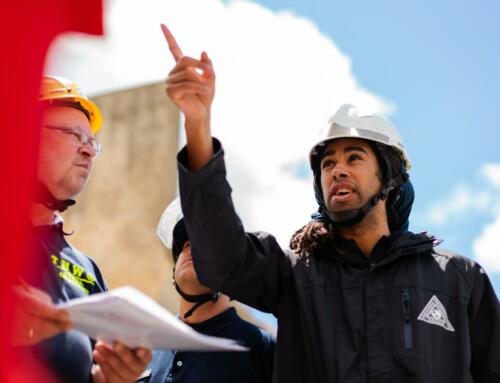
In the first two parts of our blog series about company roles, we discussed the role of the C-Suite and Senior Management, focusing on how they can use their positions to help keep their enterprise healthy and resilient during these challenging times. In this final installment, we will consider the role of Middle Management and define how this role is different from executive-level and senior-level management. Specifically, we’ll examine how middle managers can help retain employees by creating a better work environment.
Before we start, a quick primer on the three main types of company roles.
Company Roles: A Quick Breakdown
Everyone has a part to play in the human systems that allow organizations to run properly. Knowing one’s role is crucial for maintaining those systems. Ill-defined roles can lead to miscommunication, which can cause employees at all levels to feel stuck without important information. When that happens, it’s hard to enjoy your work.
Earlier, we broke down company roles into three main categories:
- The Technician: Performs specialized and focused tasks as part of their work.
- The Manager: Supervises others, encourages, and directs.
- The Leader: Oversees all functions and sets strategy for the enterprise.
Each of these roles requires a different set of skills and allows the employee to contribute in a different way. People begin gathering these skills at the technician level, and as they move up through the organization, they learn to utilize them in ways that fit their current role.
How Middle Managers Can Help Their Organization Thrive
While people in the leadership positions, such as C-Suite and department directors, are more concerned with growth, vision, and big-picture strategy, middle management’s focus is on productivity. Because they interact more closely with staff, mid-level managers are more likely to know what is happening at the front line, where products and services are produced and delivered.
That also means middle managers have a direct impact on employee job satisfaction. When that impact is negative, it can lead to attrition. While part of the staffing shortage we’re seeing right now is due to the Boomer generation’s mass retirement, that’s not the whole story. Many workers are quitting due to dissatisfaction with their jobs and with their supervisors.
It’s critical for mid-level managers to get ahead of that problem by establishing a good workplace culture where their staff feels seen, heard, and generally paid attention to. That’s always been true, but the COVID-19 pandemic has accelerated burnout rates and raised anxiety across the board — and that’s left some businesses scrambling to keep up. According to Forbes:
“Many companies didn’t, and unfortunately still don’t, have the required systems and policies to deal with the threats posed by the pandemic. The mental well-being of employees…came to the forefront, with a significant percentage feeling burned out and overstressed. While managers and leaders tried tackling the issue, without a structured approach, many lacked the competency to overcome the challenge.”
Middle managers are the ones who need to build the environment and systems for employees to thrive. It’s up to them to communicate with the technicians on the ground and get their feedback to determine whether the policies implemented by higher levels are actually working.
>> Related: How Managers & Supervisors Can Improve Organizational Culture Through Greater Inclusion
Building Up Your People
So how does that get done? As always, it’s communication that’s most important here. Middle managers should be asking:
- Do my employees receive competitive pay?
- Is there room here for people to grow?
- Do people have the tools and resources they need to do their jobs well?
As a middle manager, building trust with the people you manage will help you answer these questions and make a more positive working environment they’ll want to be part of. Whether your business is going through massive organizational change or your associates simply feel stuck in their day-to-day work, they need to know their management will be transparent with them and offer their support. You can ask people for feedback all day, but they won’t actually tell you what’s bothering them if they don’t believe you’ll solve the problem.
That said, you don’t want to end up trying to do everyone’s work for them. Middle managers are perhaps the most prone to falling back into the technician’s way of doing things, especially if work piles up due to staffing shortages. If you are in that position and you’ve just left the technician role to become a manager, you may be more comfortable reverting to it in a crisis than letting go of the hands-on control the way a manager should.
Empowering the people who actually should be doing the technician work helps prevent this from happening. Provide the training and the tools they need, educate them well, and then step back to let them do the work. Finally, let your people know that you’re there to answer any questions they might have while they’re learning the ropes. Both literally and figuratively, keep your door open.
Communicating regularly with the people you manage will also let you see where their talents lie. Once you know what they’re particularly good at, you can provide the right tools to develop those talents into valuable skills that they can take with them as their career evolves.
A Multifaceted Role
Middle managers wear a lot of hats. They’re part coach, part drill sergeant, part analyst, and a dozen other things on top of that. And much of the time, they worked as a technician alongside the people they’re managing not too long ago. Middle managers have to find a balance between colleague and manager with the people working under them.
At the core of that balance is encouraging cohesion. People have to work together as a unit to achieve their goals, and they have to understand why that’s necessary. As a manager, communicating that necessity is part of the job.
It’s also very important to let people know that working together means helping one another when someone comes up short. People are, after all, people and not machines. Rigorously expecting perfection with no room for failure is the quickest route to burnout. And that creates a work environment that leads to mass resignations.
Building a Strong Foundation
Middle managers organize the people who enable operations every day. The experience of being in the technician role is still fresh in their minds, which makes them uniquely qualified for their new role. They know exactly what their people need because they themselves were performing those same operations not that long ago. However, knowing the tricks of the trade is not enough to be successful at managing others.
A good middle manager will:
- Build trust with their staff through communication, and never publicly or intentionally humiliate them.
- Be able to negotiate not only with the people they manage but with managers above them in the organization.
- Support, educate, and empower their staff to do their best work.
- Encourage unity and cohesion.
For the sake of analogy, if the business represents a house, then the people fulfilling the technical roles are the foundation of the house. It’s the middle manager’s job to ensure the foundation doesn’t have any cracks.
Managing can be tough, especially now, but someone’s gotta do it. If you’re looking to improve your management skills and make your business better, reach out to us. We provide custom studios that help build the skills you and your team need in order to be successful. Our studios are tailored to the unique challenges each client is facing.
This article is part of a series on the importance of defining organizational roles for the overall health and success of an enterprise. It focuses specifically on Middle Management’s responsibilities within that framework. For information on additional job roles discussed in this series, click here: Senior Management | C-Suite Executives






